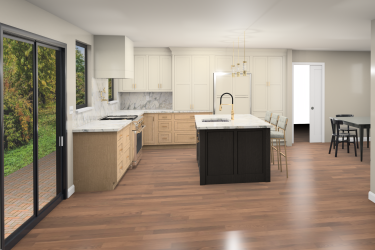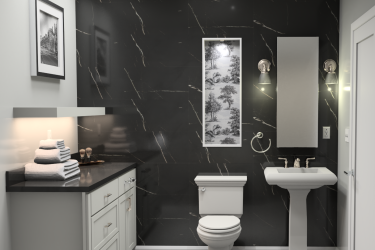COVID-19 home safety has become a priority for people everywhere as they try to protect themselves and their loved ones. The coronavirus has compelled us all to change how we live and work. Because of new restrictions and safety recommendations, we’re spending more time indoors. It looks like this isn’t going to change anytime soon. Even as restrictions ease, it will be important to have a comfortable and safe space to spend a lot of time in.
It’s not just the risk of exposure outdoors that we need to worry about; preparing your home for your family’s wellbeing is an essential part of staying safe and healthy. Having designated spaces in which to work, study, or home-school children can make things easier on you and your family. Here are some things you can do for better COVID-19 home safety and your long-term wellbeing.
1. SANITIZING SURFACES
The CDC recommends cleaning and disinfecting “high-touch surfaces daily in household common areas (e.g., tables, hard-backed chairs, doorknobs, light switches, phones, tablets, touch screens, remote controls, keyboards, handles, desks, toilets, sinks).” But how can you improve COVID-19 home safety without damaging these surfaces? The following tips will help:
Countertops
- For tile, stainless steel, and other more resilient surfaces, use a government-approved disinfectant or a disinfecting agent such as bleach in a solution. Follow the manufacturer’s instructions.
- If your countertops are made of granite, marble or other natural stones, ensure they are sealed. Many experts recommend doing this every 3 to 6 months, and it’s especially important to stay on top of that now if you are using chemical cleaners. A good clean with soap and water works well together with an alcohol-based disinfectant.
- Wooden or butcher block countertops require a hydrogen peroxide-based cleaner, followed by a good moisturizing practice for maintenance.
Floors
- Tile floors and bathroom walls can be cleaned with a bleach solution or most household disinfectants (check to see if they are government-approved).
- Hardwood and laminate floors can be damaged by moisture, so choose damp mopping with a disinfectant made specifically for hardwood floors.
- Carpets and rugs will require a carpet cleaner but look for ones with disinfecting properties.
High-touch fixtures and fittings
Door knobs, handles, switches, railings – think of how many times a day they’re touched by different members of your household. If that thought has you reaching for the bleach solution, take a minute to think about whether it would corrode the surfaces in question. Instead, you might be safer with a 70% isopropyl alcohol spray or wipes. The same goes for electronics – keys, buttons, screens. And remember to turn off switches before disinfecting them!
Furniture and soft furnishings
For your furniture and soft-furnishings, clean and disinfect with the specific material in mind. Consult the manufacturer and read product labels for more information.
In short:
- Clean surfaces clean before disinfecting them.
- Check instructions from the manufacturer of the surface as well as of the disinfectant before proceeding.
- Do a spot test with your choice of disinfectant and observe, keeping an eye out for any damage.
- Wear gloves to protect yourself from harsh chemicals while disinfecting.
2. MAXIMIZING STORAGE
Most of us are reconnecting with our kitchens during this time. You may have rediscovered a few forgotten features (and pantry items!) and thought of a few things that would make cooking at home easier. In addition to basic COVID-19 home safety, it’ll be important to make your time in the kitchen more enjoyable. We recommend starting with storage, factoring in:
- The amount of space and how you use it.
- How things are organized, so you know where everything is and when it expires.
- Storage conditions, so your fresh and dry items have the environment they need.
At Bath Plus Kitchen, we ensure all our clients know the importance of cabinetry both for kitchen design and functioning. We work with top-rated cabinet manufacturers to deliver cabinetry that suits our clients’ specific requirements. Through our virtual consultation process, we take them through different options to identify what would suit them best. For example, if maximizing storage and efficiency is a priority, we direct clients to this Dura Supreme storage brochure and similar resources. Here are some ideas you can apply to your existing kitchen or kitchen remodel:
Some more tips on maximizing storage in the kitchen:
- Throw – do a deep clean of dedicated storage spaces such as your fridge, pantry, and other cabinets. Get rid of expired products and donate what you don’t need.
- Plan – decide on how you will use the storage space you have, i.e., what will go where.
- Decant – you may need to pick up some extra containers, jars, and organizers here. Try to find a container for everything to make food last longer and easier to spot, making it less likely to be forgotten and wasted.
- Install – Try installing wall storage such as racks and shelves. You can use a pot rack in the kitchen, for example, to free up some cabinet space for more pantry essentials.
- Make space – the last thing you need when you’re trying to cook a delicious meal is a cluttered countertop. Again, wall storage can help. Bins and baskets for other items could also serve you well.
The same applies to your storage for medicines and cleaning supplies. Toss anything expired and restock with what you need to ensure COVID-19 home safety and stay healthy. Here’s a guide on what to stock up on without emptying shop shelves.
3. IMPROVING YOUR SPACE
Home Office
Overnight, people across the globe had to switch to working from home where possible. People were compelled to get creative, with some even fashioning desks out of laundry baskets. But, of course, this won’t cut it in the long run and won’t be good for your posture and overall health. Try these tips to make your home office more comfortable so you can have a productive day:
- Lighting – pick the right overhead and desk lighting so you’ll be comfortable working there regardless of the time of day. In addition, try to find a spot with good natural lighting for a health and mood boost.
- Power sockets – you may need to plug in quite a few devices, so ensure there are enough sockets available. A power extender could also help.
- Office chair and desk – check your current desk and chair to see if they’re going to be comfortable in the long run. If not, look into replacing them with more ergonomic, adjustable options
- Ergonomic accessories – an ergonomic keyboard and mouse, second monitor, and footrest are a few things you can add to your workspace to increase comfort and protect your health.
- Wi-Fi booster – if you’re jumping in and out of your Zoom meetings repeatedly due to network issues, consider a Wi-Fi booster or extender. You’ll have more flexibility, too, in case you need to make calls or work from a different part of your house at a moment’s notice.
For more ideas, check out these suggestions from Apartment Therapy:
Quarantine Space
If a family member has been exposed to the coronavirus, they will need a separate space, ideally their own room and bathroom to isolate in and prevent community spread. This is where COVID-19 home safety gets serious. Take a look at these WHO guidelines on preparing for this. In addition to safety precautions, there are a few ways you can make their living space more comfortable:
- Extra blankets and pillows – this will increase comfort and make staying in bed easier.
- Mini library – create a collection of books, magazines, and other offline entertainment that you can move to this room.
- TV or computer – keep boredom at bay and their spirits up by making it easier for them to watch their favorite shows, for example. The right devices can make video calling easier as well, which will keep them from feeling cut off from the rest of the family. Consider a Wi-Fi booster if need be.
- Snacks – keep a good supply of healthy snacks in the room to cheer them up. It’ll also minimize how often you need to take food to them.
Here are some more ideas on setting up a DIY emergency containment room:
Home Remodel
To help our clients improve their homes during these uncertain times, we’ve created a virtual design process with a physical component that includes samples being mailed to them. At the end of it, they will have a design that’s ready to go. After that, we’ll work out a suitable start date for the project. If you’re ready to plan a remodel and create a more comfortable living space, here are some factors to consider in light of the pandemic:
- Easy-to-clean, resilient surfaces – with all the sanitizing and cleaning we have to do now for COVID-19 home safety, low-maintenance countertops, floors, tiles, hardware, and fittings are a good idea.
- Touchless tech – don’t stop at smart gadgets; think touchless tech. Touchless and keyless technology for opening doors and turning on lights can make for a cleaner, safer living experience long-term.
- Outdoor living spaces – if you have an outdoor space, consider how you would like to use it better and what you can add to encourage family members to spend more time there. Creating a relationship between indoor and outdoor spaces can improve your experience as well, and here are some tips on how to do that:
Making sure your home is sanitized and safe is an important and wonderful start. However, in the long run, you can keep yourself and your family members safe by making indoor spaces more inviting, engaging, and conducive to recreational and productive activities. We don’t know how much longer we’ll have to take these precautions for, but it’s an opportunity to reflect on our living spaces and make them a joy to spend more time in. To get started, sign up for a virtual consultation with Bath Plus Kitchen.





